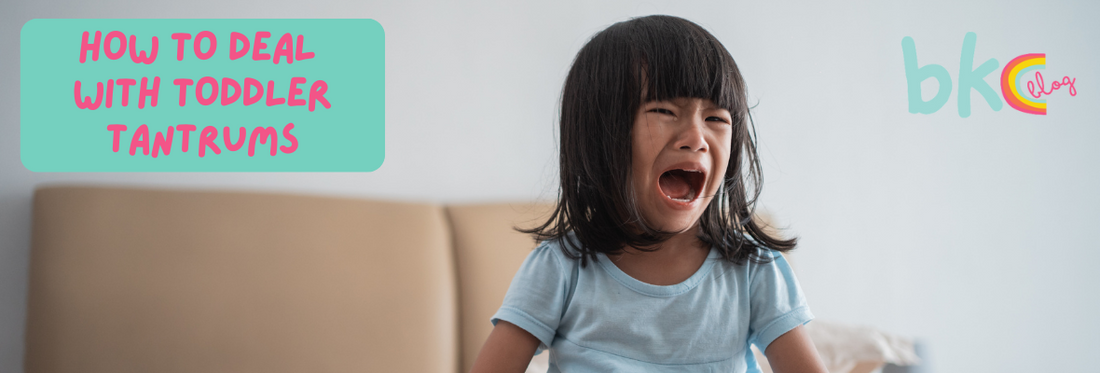As the parent of a toddler, it takes a ridiculous amount of patience to diffuse your child’s tantrum. The key to making this process easier is to understand the why and how of a tantrum. Read on as we dissect your toddler’s meltdowns.

Let’s conjure up a realistic scene: It’s your child’s mealtime; you have just served them lunch on their favourite plate. They take one look at their plate; and start to bawl and kick in frustration. You have no clue what’s led to this sudden change in demeanour. It takes you a few minutes to realise that they are throwing a fit because one of the items on the plate is slightly touching another item. Setting the items apart should be the end of it, but turns out it’s not. A yawn – amidst the cryfest – gives away the source of your toddler’s tantrum as tiredness and hunger.
Toddler tantrums usually start at around 18 months. While this may sound like the end of the world, it’s not if you know how to deal with them. This article is Toddler Tantrum 101.
The Science Behind Toddler Tantrums
Tantrums happen because little children lack the ability to express and regulate their emotions. That is, they often don’t have the words to explain what they are feeling, and are yet to learn how to soothe and calm themselves when they are feeling anxious, stressed, or angry. As a result, even something as simple as feeling excessively hungry or tired and sleepy (as evidenced in the example above) can lead to a full-blown meltdown.

Tantrums can also be caused by frustration, such as if your child is unable to take their shoes off on their own or if an older child takes away a toy. Other triggers include feeling ill and overstimulation, which happens because of overwhelm from too many sensations, noise, or activities. It’s important to remember that tantrums are absolutely normal, and common among children aged 1 to 4.
Tame Tantrums, Not Your Toddler
There are some ways to avoid tantrums, such as making sure your child is fed at regular intervals and is sleeping an age-appropriate number of hours. It’s also helpful to give toddlers choices – eg. instead of triggering a meltdown by asking your child to brush their teeth when you sense they don’t want to, approach the situation by asking them “Would you like to brush your teeth with the blue toothbrush or the green?”.
But ultimately, there is only so much in your hands. If you’re currently living with a toddler, it’s best to accept that tantrums will happen, and work on arming yourself with the right strategies to manage them when they do occur:
1. Analyse
Next time there is a tantrum, take a quick moment to try and identify the reason. If it’s because your little one is sleepy or hungry or overstimulated, the fix is simple. Understanding the reason for the tantrum will also help you empathise better with your kid, and help you stay calm. Which brings us to our next and very crucial strategy…
2. Stay Calm

First and foremost, while in the middle of a tantrum, it’s unlikely your child is going to calm down if you’re not calm. Toddlers are like sponges when it comes to feelings, and if you’re able to keep the peace, it’s likely they will come around sooner rather than later. Hard as it may seem, take a deep breath, remind yourself that your kid isn’t acting out out of ill will, and that you need to literally and otherwise, be the bigger person. Trust yourself. You’ve got this.
Second, it may sound trite, but children learn by example. So next time you’re feeling upset or frustrated, show your toddler that those feelings can be navigated in a calm and positive way. Stuck in a traffic jam? Tell your toddler that it looks like you’re going to be late, and it’s frustrating you. Then take a few deep breaths, and tell your toddler how doing that is making you feel better.
3. Distract
Toddlers are easily distracted – it’s just how they’re wired. Use this to your advantage next time there is a tantrum. First, change their location. Perhaps take your kid to a window or step outside and point out something that might interest them. For example, “Oh wow! Look at that yellow school bus. Let’s wait and see if any more will pass by”. Remember, sounding super excited yourself is key here.
Alternatively, you can try and involve them in a new activity. It could be absolutely anything – for example “Look at all these pea pods! Let’s shell them together!” – as long as it’s something your child finds engaging enough as a distraction from their outburst.
4. Prioritise Safety
Sometimes, while in the heat of a tantrum, toddlers may hurt themselves (such as by hitting a wall) or others (for example, by throwing a toy). Immediately remove your child from the situation. If your child is hurting another child, hold them firmly till they calm down. Try and redirect their emotions: “You are feeling angry, but I cannot let you hurt yourself/your friend. Let’s see what else we can do…”.

If they’ve still got big feelings, allow them to punch a pillow or give them crayons and paper to draw their feelings. No matter how upset you feel in such a situation, do not hit back. This may lead your child to believing that it is okay to be aggressive.
5. Talk It Out!
There is really no point trying to reason with a child in the midst of a tantrum. However, once the dust has settled, talk to your kid about what happened. Sit down with them and speak in a cool, comforting voice. Help them identify the emotion they were feeling – for example, “You felt angry because Sara took your teddy”. This will give them the words to communicate their feelings next time. Then calmly tell them what is not acceptable when it comes to expressing big feelings (“It’s okay to feel angry, but it’s not okay to hurt others.”).
Involve them in the process of finding a solution. (“You’re feeling frustrated because you wanted to go on the swing. But Ira is taking her turn right now. What can we do instead? Would you like to go on the slide or the see-saw?”)
Pro Tip: Never change your tune mid-tantrum. If, for example, your kid is having a tantrum because they wanted candy at bedtime and you refused, whatever you do, don’t give in. If you do yield, it will only reinforce their behaviour.
How to Avoid Public Tantrums
As a toddler parent or caregiver, a public tantrum is probably one of your worst nightmares. The good news is, handling a public tantrum doesn’t require any special strategies apart from the ones we’ve listed already – just a few tweaks and additions:
-
Before going out, explain to your child about the itinerary and how you expect them to behave.
-
Avoid going out when your child is hungry. If you are outside closer to their snack or mealtime, be prepared with food. Try to feed them before they reach the ‘hangry’ mood.
-
Try not to leave the house during their nap time. If you have to, be prepared for the situation. A smaller nap in their reclining stroller or the seat of the restaurant you are dining in may help.
-
Be prepared to handle tantrums. For instance, if you experience a meltdown during a grocery run, you might need to end your trip sooner.

-
Pay attention to your child’s varying moods. If they get cranky, get down to their level (literally!) and talk to them.
-
Keep outings fun. If you are on a grocery run, try to get your child involved (for example, “Can you help Mama find sugar?” or play the ‘I Spy’ game).
-
Don’t sweat about who is watching. Most of the time, people around you will be empathetic. Take a deep breath and focus on your child.
-
While you can’t steer clear of tantrums entirely, you can avoid them to an extent. You can stay away from the triggers. You know what and where they are (yes, we are talking about the aisle of toys).
No matter how patient and mindful you are as a parent, dealing with your toddler’s meltdowns can unlock new levels of embarrassment and desperation for you. It is crucial to understand that your response to your child will teach them how to respond to difficult emotions. At the same time, it is also healthier to accept that there is no such thing as perfect parents and well-adjusted kids.

